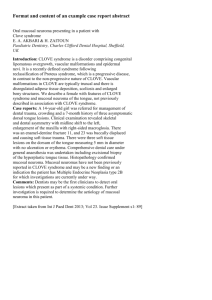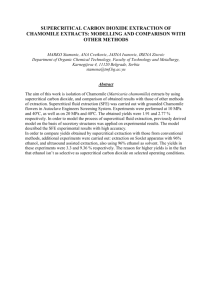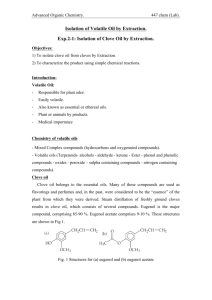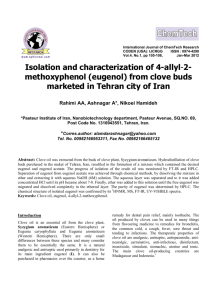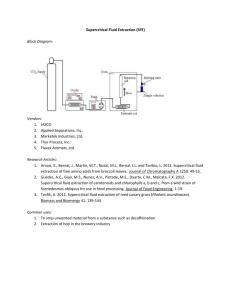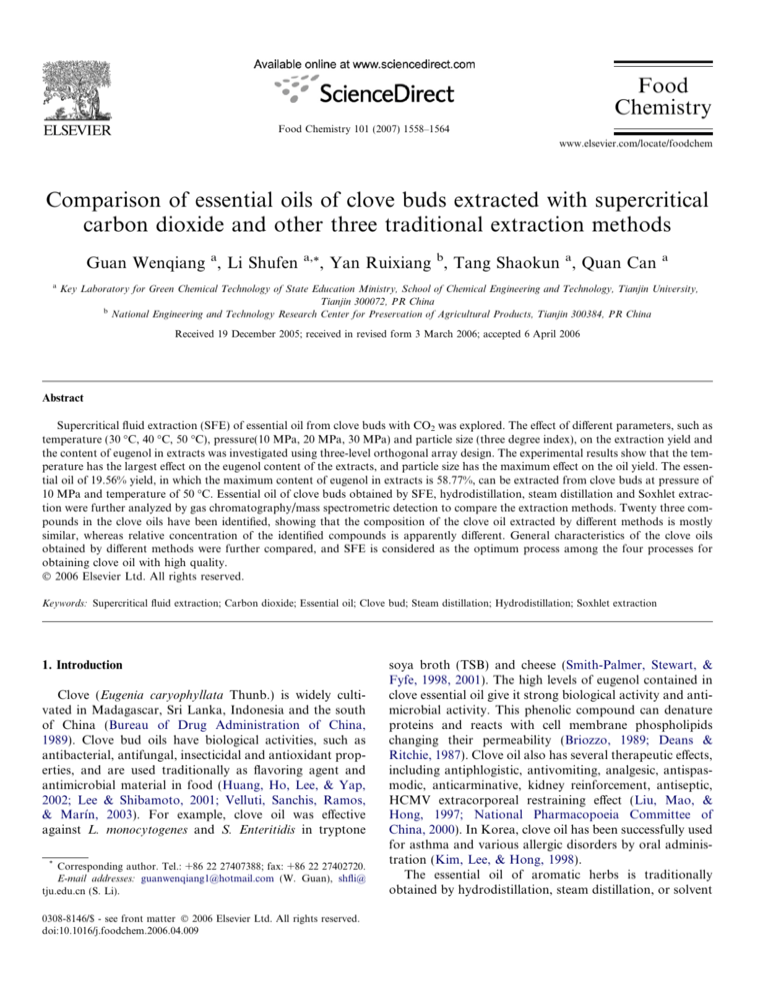
Food
Chemistry
Food Chemistry 101 (2007) 1558–1564
www.elsevier.com/locate/foodchem
Comparison of essential oils of clove buds extracted with supercritical
carbon dioxide and other three traditional extraction methods
Guan Wenqiang a, Li Shufen
a
a,*
, Yan Ruixiang b, Tang Shaokun a, Quan Can
a
Key Laboratory for Green Chemical Technology of State Education Ministry, School of Chemical Engineering and Technology, Tianjin University,
Tianjin 300072, PR China
b
National Engineering and Technology Research Center for Preservation of Agricultural Products, Tianjin 300384, PR China
Received 19 December 2005; received in revised form 3 March 2006; accepted 6 April 2006
Abstract
Supercritical fluid extraction (SFE) of essential oil from clove buds with CO2 was explored. The effect of different parameters, such as
temperature (30 C, 40 C, 50 C), pressure(10 MPa, 20 MPa, 30 MPa) and particle size (three degree index), on the extraction yield and
the content of eugenol in extracts was investigated using three-level orthogonal array design. The experimental results show that the temperature has the largest effect on the eugenol content of the extracts, and particle size has the maximum effect on the oil yield. The essential oil of 19.56% yield, in which the maximum content of eugenol in extracts is 58.77%, can be extracted from clove buds at pressure of
10 MPa and temperature of 50 C. Essential oil of clove buds obtained by SFE, hydrodistillation, steam distillation and Soxhlet extraction were further analyzed by gas chromatography/mass spectrometric detection to compare the extraction methods. Twenty three compounds in the clove oils have been identified, showing that the composition of the clove oil extracted by different methods is mostly
similar, whereas relative concentration of the identified compounds is apparently different. General characteristics of the clove oils
obtained by different methods were further compared, and SFE is considered as the optimum process among the four processes for
obtaining clove oil with high quality.
2006 Elsevier Ltd. All rights reserved.
Keywords: Supercritical fluid extraction; Carbon dioxide; Essential oil; Clove bud; Steam distillation; Hydrodistillation; Soxhlet extraction
1. Introduction
Clove (Eugenia caryophyllata Thunb.) is widely cultivated in Madagascar, Sri Lanka, Indonesia and the south
of China (Bureau of Drug Administration of China,
1989). Clove bud oils have biological activities, such as
antibacterial, antifungal, insecticidal and antioxidant properties, and are used traditionally as flavoring agent and
antimicrobial material in food (Huang, Ho, Lee, & Yap,
2002; Lee & Shibamoto, 2001; Velluti, Sanchis, Ramos,
& Marı́n, 2003). For example, clove oil was effective
against L. monocytogenes and S. Enteritidis in tryptone
*
Corresponding author. Tel.: +86 22 27407388; fax: +86 22 27402720.
E-mail addresses: guanwenqiang1@hotmail.com (W. Guan), shfli@
tju.edu.cn (S. Li).
0308-8146/$ - see front matter 2006 Elsevier Ltd. All rights reserved.
doi:10.1016/j.foodchem.2006.04.009
soya broth (TSB) and cheese (Smith-Palmer, Stewart, &
Fyfe, 1998, 2001). The high levels of eugenol contained in
clove essential oil give it strong biological activity and antimicrobial activity. This phenolic compound can denature
proteins and reacts with cell membrane phospholipids
changing their permeability (Briozzo, 1989; Deans &
Ritchie, 1987). Clove oil also has several therapeutic effects,
including antiphlogistic, antivomiting, analgesic, antispasmodic, anticarminative, kidney reinforcement, antiseptic,
HCMV extracorporeal restraining effect (Liu, Mao, &
Hong, 1997; National Pharmacopoeia Committee of
China, 2000). In Korea, clove oil has been successfully used
for asthma and various allergic disorders by oral administration (Kim, Lee, & Hong, 1998).
The essential oil of aromatic herbs is traditionally
obtained by hydrodistillation, steam distillation, or solvent
W. Guan et al. / Food Chemistry 101 (2007) 1558–1564
extraction. These processes cost not expensive but can
induce thermal degradation, hydrolysis and water solubilization of some fragrance constituents. Extracts obtained by
solvents contain residues that pollute the foods and fragrances to which they are added. These disadvantages
can be avoided by using the supercritical fluid extraction
(SFE) process (Mostafa, Yadollah, Fatemeh, & Naader,
2004; Reverchon, 1997). It is well known and SFE has been
established as an environmentally benign technique for
separating essential oils from the vegetable substrates.
Moreover, extracts obtained by SFE can retain the organoleptic characteristics of the starting spice material (Biljana,
Zika, Vladimir, & Aleksandar, 2005).
Supercritical CO2 extraction of cloves oil has been performed previously by some authors (Della Porta, Taddeo,
D’Urso, & Reverchon, 1998; Liu, Chen, Chen, & Chang,
2003; Reverchon & Marrone, 1997; Rodrigues et al.,
2002). The conditions explored were at pressures from 10
to 50 MPa and temperatures ranging from 30 to 40 C.
Compounds with high molecular weight and coloring
materials, such as chlorophyll, were recovered together
with the fragrance constituents owing to the high pressures
utilized. For example, in the extraction performed by
Gopalakrishnan, Shanti, and Narayanan (1990), increasing
the extraction pressure from 10 to 50 MPa at a temperature
of 40 C resulted in an increase of the chlorophyll content
in the extract (Gopalakrishnan et al., 1990). Comparison of
some essential oils obtained by SFE with conventional
methods and GC analysis of clove oil in ethanol had been
studied by some authors (Myint, Wan, Mohamad, & Kadhum, 1996; Reverchon & Senatore, 1992; Scalia & Giuffreda, 1999), however, none of investigations has
examined in detail the comparison of essential oil composition between clove buds oil obtained by SFE and the conventional extraction techniques such as hydrodistillation,
steam distillation, and solvent extraction.
Since the clove oil has been used widely as pharmaceuticals, flavoring and antimicrobial agents in food industry, it
is necessary to find the most suitable method for the
improvement of the quality of clove oil. The aim of this
work is to compare clove oils obtained by the supercritical
CO2 extraction with other three traditional methods, in
which extraction of clove oil from clove buds with supercritical CO2 was first investigated intensively. Compositions of
clove oil were analyzed by gas chromatography (GC) and
gas chromatography–mass spectrometry (GC–MS).
2. Materials and methods
2.1. Materials
The buds of clove (E. caryophyllata Thunb.) were purchased from Tianjin factory for Chinese herbs. The samples were dried at 30 C in a ventilated drying oven and
stored in plastic bags at ambient temperature and protected from light. The samples were ground by a FW80
Sample Mill (Taisite CO., Tianjin, China) in different peri-
1559
ods to get the different particle distribution, which was
measured by mechanical sieving after extraction and calculated by weight of different size of clove bud particle.
Grades of particle size was classified on the following scale:
1 > 10 mesh; 2 = 10–20 mesh; 3 = 20–40 mesh; 4 = 40–
60 mesh; 5 = 60–80 mesh; 6 = 80–100 mesh; 7 = 100–
120 mesh; 8 < 120 mesh. Particle size index was
P calculated
by following formula: Particle size index = (weight of
each grade · grade)/(total weight · highest grade). The
particle size index of material in this experiment was
0.7944, 0.6430, 0.5223, and named as 1#, 2# and 3#,
respectively.
The solvents and chemicals were obtained from following sources: carbon dioxide, 99.99% purity, from Tianjin
Anxing gas factory; China. Dichloromethane, purity > 99.9%, from Tianjin chemical Co., China; Eugenol,
Purity P 99.0% (GC), from Fluka Co., Germany; Eugenol
acetate, Purity > 90.0% (GC), TCI America Co., Japan.
2.2. Experimental apparatus and methods
2.2.1. Supercritical CO2 extraction
Extraction of essential oil from clove buds was experimentally determined using the Speed SFE instrument
(Applied Separations Inc., Allenton, PA, USA). Liquid
CO2 was pressurized with a high-pressure pump and then
charged into the extraction column to desired pressure.
The pressure was controlled to an accuracy of about 1%
over the measuring range. The extraction column was
32 ml with 14.40 mm inner diameter and 195 mm length,
being packed with powdered raw materials and glass beads.
The extraction column was heated with an oven and its temperature was indicated and controlled by a thermocouple to
within ±1 C. The supercritical CO2 with dissolved compounds passed through a heated micrometer valve, and
was subsequently expanded to ambient pressure. The
extract was precipitated in a collect vial at ambient pressure
and temperature. A calibrated wet-test meter at known temperature and pressure measured the total amount of CO2.
For each extraction test, the extractor was charged with
about 15 g of ground clove bud powder. CO2 flow rates
ranging about 2 l/min were used. The oil weight was measured by precision balance until no oil was extracted out
from the clove bud powder.
2.2.2. Hydro and steam distillation
The plant (100 g of dried and ground clove buds) in
500 ml flask was submitted to hydrodistillation for 4–6 h
and steam distillation for 8–10 h.
The volatile distillate was collected until no oil drop out.
The distillate was saturated with sodium chloride and
added with some ether. Then, the ether layer and hydro
layer were separated by funnel. After dehydrated by anhydrous sodium sulphate, the ether layer was further heated
in 60 C water bath to make oil to be concentrated and
the ether to be recovered. The oil was weighed and refrigerated prior to analysis.
1560
W. Guan et al. / Food Chemistry 101 (2007) 1558–1564
2.2.3. Solvent extraction
The ground clove bud samples (30 g) were weighed and
quantitatively transferred into a filter paper extraction
thimble and inserted into a 500-ml reflux flask, then
extracted with 250 ml absolute ethanol for about 6 h in a
Soxhlet apparatus (Quan et al., 2004). After Soxhlet extraction, extracts were concentrated using rotary vacuum evaporator at 50 C.
2.2.4. GC and GC/MS analysis
GC analyses were performed using a Shimadzu GC2010 gas chromatograph equipped with a FID and a DB5 fused-silica column (30 m · 0.25 mm i.d., film thickness
0.25 lm, Agilent). Oven temperature was 80 C for 2 min,
then programmed heating from 80 to 230 C at a rate of
6 C/min, and at 230 C for 2 min. Injector and detector
temperatures were 230 C. The carrier gas, nitrogen, was
adjusted to a linear velocity of 24 ml/min. The samples
(0.1% in absolute ethanol) were injected into the GC by
split mode with a split ratio of 1/20. Methyl salicylate
was used as internal standard.
GC/MS analyses were performed using Finnigan Trace
GC/DSQ equipped with a BTX.5ms fused-silica capillary
column (15 m · 0.25 mm i.d., film thickness 0.25 lm,
RESTEK CORP.). Oven temperature conditions were:
40 C for 1 min, then programmed heating from 40 to
200 C at a rate of 6 C/min and from 200 to 280 C at
a rate of 30 C/min. Injector temperature was 250 C.
The carrier gas, helium, was adjusted to a linear velocity
of 1 ml/min. Ion source temperature was 250 C;The ionization energy was 70 eV with a scan time of 1 s and mass
range of 20–500 AMU. Samples were run in dichloromethane with a dilution of 0.1% (V/V). Compounds were
identified by matching their mass spectra and retention
times with those of pure compounds whenever possible.
NIST (National Institute of Standards and Technologies)
Mass Spectra Library was also used as a reference (see
Table 1).
3. Results and discussion
3.1. Yield and eugenol content of the oil extracted by SFE
The following parameters was used: temperature, 30 C,
40 C and 50 C; Pressure, 10 MPa, 20 MPa and 30 MPa;
particle size, 1#(0.7944), 2#(0.6430) and 3#(0.5223). All
the selected factors were examined by using a three-level
orthogonal array design with an OA9 (33) matrix. Table
2 shows the experimental conditions for each of the SFE
runs. It can be seen from the order of the maximum differences that the particle size had the most influence on the oil
yield, then the temperature and pressure. However, the
sequence of the influences of the parameters on the eugenol
content in the oils was temperature, particle size, and pressure. That is, the factor of temperature has the maximum
influence on the eugenol content in the oils.
Fig. 1 shows the effect of temperature, pressure and
particle size on the yield and eugenol content of clove
Table 1
Three-level orthogonal design and experimental results for extraction of clove oil with SC–CO2
Factor A (T/C)
Factor B (P/MPa)
Factor C (particle size/#)
Yield (kg extract/kg feed)
Eugenol content (%)
Run No.
1
2
3
4
5
6
7
8
9
1(30)
1(30)
1(30)
2(40)
2(40)
2(40)
3(50)
3(50)
3(50)
1(10)
2(20)
3(30)
1(10)
2(20)
3(30)
1(10)
2(20)
3(30)
1(1#)
2(2#)
3(3#)
3(3#)
1(1#)
2(2#)
2(2#)
3(3#)
1(1#)
0.2056
0.1943
0.1830
0.1910
0.2224
0.2043
0.1956
0.1827
0.2395
53.69
54.22
55.64
56.20
54.52
55.30
58.77
57.83
56.97
Yield (%)
K1
K2
K3
K1/3
K2/3
K3/3
R
0.5830
0.6178
0.6179
0.1943
0.2059
0.2060
0.0117
0.5923
0.5995
0.6269
0.1974
0.1998
0.2090
0.0116
0.6676
0.5942
0.5568
0.2225
0.1981
0.1856
0.0369
168.66
166.57
167.91
56.22
55.52
55.97
0.25
165.18
168.29
169.67
55.06
56.10
56.56
1.04
Eugenol content (%)
K1
163.55
K2
166.02
K3
173.57
K1/3
54.52
K2/3
55.34
K3/3
57.86
R
3.34
P
=1.8186
P
=503.14
Table 2
Composition of clove oil obtained by different methods
4-(2-propenyl)-Phenol
a-Cubebene
Eugenol
a-Copaene
Caryophyllene
a-Humulene
Isoledene
c-Muurolene
a-Muurolene
a-Farnesene
Unidentified
Cadinene
Eugenol acetate
Cubenol
unidentified
Caryophyllene oxide
Diethyl Phthalate
1,4-Methanoazulen-7(1H)-one, octahydro-4,8,
Tetracyclo[6.3.2.0(2,5).0(1,8)]tridecan-9-ol, 4,4-dimethylTetracyclo[6.3.2.0(2,5).0(1,8)]tridecan-9-ol, 4,4-dimethylIsoaromadendrene epoxide
2,2,4-Trimethyl-3-(3,8,12,16)-tetramethyl-heptadeca-3,7
Tetratetracontane
Run 1
Run 2
Run 3
Run 4
Run 5
Run 6
Run 7
Run 8
Run 9
SDb
HDc
10.91
12.79
13.21
13.34
14.23
14.88
15.32
15.44
15.79
16.1
16.17
16.31
16.6
16.91
17.06
17.41
17.8
17.92
18.35
18.42
19.07
30.6
30.82
0.38
0.53
53.8
0.95
17.77
2.32
0.08
0.37
0.28
0.25
0.06
0.71
20.91
–
–
0.8
0.12
0.11
0.11
0.21
0.14
–
–
0.48
0.51
54.58
0.63
17.32
2.26
–
0.4
0.27
0.23
0.07
0.68
20.55
–
–
0.88
0.35
0.13
0.14
0.27
0.25
–
–
0.49
0.49
55.07
0.86
16.78
2.15
–
0.37
0.28
0.29
–
0.67
20.49
–
–
0.93
0.33
0.12
0.13
0.27
0.15
–
0.15
0.45
0.45
55.18
0.5
16.52
2.15
0.11
0.35
0.22
0.32
–
0.64
20.89
–
–
0.69
1.1
–
–
0.3
0.12
–
–
0.47
0.48
54.79
0.57
16.62
2.13
–
0.36
0.22
0.22
0.06
0.65
20.78
–
–
0.84
0.74
0.12
0.14
0.26
0.15
0.24
0.14
0.46
0.43
55.14
0.51
15.52
2.02
–
0.36
0.22
0.2
0.07
0.64
20.32
–
–
0.93
1.43
0.15
0.14
0.25
0.25
0.73
0.22
0.46
0.32
57.36
0.65
13.99
1.9
–
0.65
–
0.2
–
0.68
22.34
–
–
0.89
–
–
–
0.37
–
–
–
0.45
0.4
56.81
0.72
15.73
2.08
–
0.42
–
0.27
–
0.66
21.5
–
–
0.6
–
–
–
0.36
–
–
–
0.44
0.4
55.94
0.76
15.71
1.95
–
0.32
–
0.22
–
0.62
21.75
–
–
1.05
–
–
–
0.56
0.28
–
–
0.35
0.47
58.2
0.81
20.59
2.61
0.41
0.26
0.85
48.82
1.93
36.94
4.41
0.55
0.19
–
0.37
–
1.46
3.89
–
–
0.32
–
–
–
–
–
–
–
–
0.27
–
1.05
13.84
0.52
0.41
0.49
–
–
–
–
–
–
–
SOd
0.52
57.24
0.93
17.5
2.03
–
–
0.16
0.5
0.72
19.37
–
–
0.49
–
–
–
0.54
–
–
–
W. Guan et al. / Food Chemistry 101 (2007) 1558–1564
1
2
3
4
5
6
7
8
9
10
11
12
13
14
15
16
17
18
19
20
21
22
23
RTa
– = undetectable.
a
Retention time on BTX.5ms fused-silica capillary column.
b
Steam distillation.
c
Hydrodistillation.
d
Soxhlet extraction.
1561
W. Guan et al. / Food Chemistry 101 (2007) 1558–1564
0.23
60
0.22
58
0.21
56
0.20
54
0.19
52
0.18
Eugenol in oil (%)
Yield (kg extract/kg feed)
1562
50
30
40
Temperature (oC)
50
10
20
30
Pressure (MPa)
Eugenol content
Yield
1#
2#
3#
Particle size (index)
Fig. 1. Effect of temperature, pressure and particle size on yield and eugenol content of clove oil extracted by supercritical CO2.
oil extracted by supercritical CO2. It can be observed that
the increase of temperature from 30 C to 40 C results in
the increase of the extraction yield and high eugenol content in the oils, while the increase of temperature from
40 C to 50 C does not result in the increase of the oil
yield, and there is increase of eugenol content in clove
oil. This is ascribed to the decrease of the CO2 density
with increasing temperature, which dominates over the
increase of the solute vapor pressure at this certain pressure (Lou, Folas, Voutasa, & Magoulas, 2003). As it
was expected, the extraction yield enhanced significantly
with increase of pressure, due to the increase of the solubility of the oil components. This is attributed to the
increase of the CO2 density, which results in the increase
of its dissolving ability. However, as the high-molecular
weight compounds in clove buds (fatty acids, fatty acids
methyl esters, sterols, etc.) were also co-extracted with
increase of the pressure, the eugenol content of the clove
oil does not change obviously. Therefore, the highest
eugenol content of the clove oil is extracted at 50 C
and 10 MPa.
The extraction yield increases by decreasing the particle
size of the comminuted clove buds. It is due to the higher
amount of oil released as the bud cells are destroyed by
milling (Mostafa et al., 2004; Reverchon, 1997), and this
amount of oil is easily extracted for direct exposure to
the supercritical CO2. Moreover, shorter diffusion paths
in the milled solid matrix result in a smaller intraparticle
resistance to diffusion. However, the eugenol content in
the clove oil increases as the particle size increase. Therefore, the particle size should not be too small if the aim
is to extract the volatile ingredients and to avoid more compounds with high-weight molecules to be co-extracted. It is
better for the particle size index to be controlled at about
0.6430(2#).
3.2. Composition of clove oil obtained by different methods
Table 2 lists the composition of clove oil obtained by different methods according to the results of GC–MS. It can
be seen that, twenty three compounds in the clove oils have
been identified, in which eugenol, b-caryophyllene and
eugenol acetate are the main components of clove oil. The
composition of the clove oil extracted by different methods
is mostly similar, whereas relative concentration of the identified compounds is apparently different. Clove oil obtained
by steam distillation contained highest percentage of eugenol (58.2%), then did oil obtained by SFE (53.8–55.9%).
Clove oil obtained by hydrodistillation had the lowest percentage of eugenol (48.82%). However, clove oil obtained
by SFE contained the highest percentage of eugenol acetate
(20.32–21.75%), which is also the main antioxidant ingredients in clove oil (Lee & Shibamoto, 2001). The highest percentage of active antioxidant ingredients, eugenol together
with eugenol acetate, in the extracted clove oil by SFE
was therefore obtained. The content of eugenol and eugenol
acetate in the extracted clove oil by Soxhlet method was also
higher than those by the two kinds of distillation methods.
Thermal degradation of eugenol acetate may take place
during hydro and steam distillation as eugenol acetate
was only 13.84%, 3.89%, respectively.
Besides eugenol, and eugenol acetate in clove oil, relative content of b-caryophyllene in the clove oil extracted
by steam distillation, hydrodistillation, SFE and Soxhlet
method was as high as 20.59%, 36.94%, 13.99–17.77%
and 17.5%, respectively. It was reported that b-caryophyllene showed anti-inflammatory activity in several experiments (Ghelardini, Galeotti, Di Cesare Mannelli,
Mazzanti, & Bartolini, 2001). If the aim was to obtain high
content of b-caryophyllene in the clove oil, it maybe necessary to choose hydrodistillation.
W. Guan et al. / Food Chemistry 101 (2007) 1558–1564
1563
Table 3
Characteristic of the clove oils obtained by different methods
Clove oil
Yield (%)
Eugenol plus eugenol acetate (%)
Extraction period (h)
Color and texture
Organic solvent used
SFE (50 C, 10 MPa)
Steam distillation
Hydrodistillation
Soxhlet extraction
19.6
10.1
11.5
41.8
58.8 + 19.6
61.2 + 10.2
50.3 + 3.2
30.8 + 9.3
2
8–10
4–6
6
Pale yellow oil
Pale yellow oil
Brown yellow oil
Brown ointment
No
Yes
Yes
Yes
It can also be seen that the oil obtained by SFE contains
small amount of co-extracted cuticular waxes. This result is
similar to other author’s work (Mostafa et al., 2004; Myint
et al., 1996).
3.3. Comprehensive comparison of the clove oils obtained by
different methods
Color and texture are the prime characteristics and quality factors of essential oil, and extraction yield and extraction time are the important factor for the industrialization.
Therefore, comprehensive comparisons of the clove oils
obtained by different methods were further listed in Table
3. In Table 3, the content of eugenol and eugenol acetate
was determined by GC.
It can be seen from Table 3 that, the content of the main
biological ingredients of eugenol plus eugenol acetate in the
clove oil by Soxhlet extraction is the lowest although its
yield of the clove oils is the highest among the four extraction methods. Furthermore, the extracts by Soxhlet
method is brown ointment, which means more undesired
impurities and organic solvent residue may existed. SFE
offers the most important advantages over other methods.
Extraction yield of SFE was about two times as high as
that obtained by steam and hydrodistillation. The highest
content of eugenol plus eugenol acetate in the extracted
oil was obtained. Pale yellow oil is desired and shortest
extraction time is needed for SFE compared with other
three extraction methods. Additionally, using supercritical
CO2 instead of some harmful organic solvents would result
in ‘‘greener’’ processes.
4. Conclusions
In the investigation of the effect of the three tested
parameters (pressure, temperature and particle size) on
the SFE extraction of essential oils from clove bud within
the experimental domain. Particle size had the most apparent effect on the yield of essential oil; temperature was the
most important factor for determining the content of eugenol of the clove oil. The possibility of manipulating the euenol content of the clove bud oil by changing the parameters
of the extraction is attainable in SFE.
The composition and some character of clove oil
obtained by SFE and other methods were compared.
Although compositions of the oils obtained by SFE and
steam, hydrodistillation are similar, they do differ quantitatively. Extraction yield of SFE was about two times as high
as that obtained by steam and hydrodistillation. SFE offers
many important advantages over other three traditional
methods, including higher extraction yield, the highest percentage of active antioxidant ingredients of eugenol together
with eugenol acetate in the extracted clove, shorter extraction time, and so on. Therefore, SFE is considered as the
optimum process for obtaining clove oil with high quality.
Acknowledgements
The authors are grateful for the financial support received from Tianjin Academy of Agricultural sciences
through project PRESIDENTFUND-2004018, which
made this study possible, and give a special thanks to
Gao Xiaochen (School of Chemical Engineering and Technology, Tianjin University) for his collaboration and participation in this study.
References
Biljana, D., Zika, L., Vladimir, Z., & Aleksandar, T. (2005). Extraction of
fennel (Foeniculum vulgare Mill.) seeds with supercritical CO2: Comparison with hydrodistillation. Food Chemistry, 92, 143–149.
Briozzo, J. (1989). Antimicrobial activity of clove oil dispersed in a
concentrated sugar solution. Journal of Applied Bacteriology, 66, 69–75.
Bureau of Drug Administration, Ministry of Public Health, PR China
(1989). Chinese traditional medicine material manual. Beijing: People’s
Medical Press.
Deans, S. G., & Ritchie, G. (1987). Antibacterial properties of plant
essential oils. International Journal of Food Microbiology, 5, 165–180.
Della Porta, G., Taddeo, R., D’Urso, E., & Reverchon, E. (1998).
Isolation of clove bud and star anise essential oil by supercritical CO2
extraction. Lebensmittel-Wissenschaft und-Technologie, 31, 454–460.
Ghelardini, C., Galeotti, N., Di Cesare Mannelli, L., Mazzanti, G., &
Bartolini, A. (2001). Local anaesthetic activity of b-caryophyllene. II
Farmaco, 56, 387–389.
Gopalakrishnan, N., Shanti, P. P. V., & Narayanan, C. S. (1990).
Composition of clove bud oil extracted using carbon dioxide. Journal
of the Science of Food and Agriculture, 50, 111–117.
Huang, Y., Ho, S. H., Lee, H. C., & Yap, Y. L. (2002). Insecticidal
properties of eugenol, isoeugenol and methyleugenol and their effects
on nutrition of Sitophilus zeamais Motsch. (Coleoptera: Curculionidae) and Tribolium castaneum (Herbst) (Coleoptera: Tenebrionidae).
Journal of Stored Products Research, 38, 403–412.
Kim, H. M., Lee, E. H., & Hong, S. H. (1998). Effect of syzygium
aromaticum extract on immediate hypersensitivity in rats. Journal of
Ethnopharmacology, 60, 125–131.
Lee, K. G., & Shibamoto, T. (2001). Antioxidant property of aroma
extract isolated from clove buds [Syzygium aromaticum (L.) Merr. et
Perry]. Food Chemistry, 74, 443–448.
Liu, B., Chen, K., Chen, W., & Chang, Q. (2003). Supercritical CO2
extraction of clove bud oil and the analysis of oil with GC–MS. Flavor,
Fragrance and Cosmetic, 3(3–4), 26 (in Chinese with english abstract).
Liu, H., Mao, P., & Hong, S. (1997). Study on the virus function of
extracorporeal restraining HCMV by Chinese traditional medicine
1564
W. Guan et al. / Food Chemistry 101 (2007) 1558–1564
Eugenia caryophyllata Thunb. Medical Journal of Chinese People’s
Liberation Army, 1, 73–75.
Lou, V., Folas, G., Voutasa, E., & Magoulas, K. (2003). Extraction of
parsley seed oil by supercritical CO2. Journal of Supercritical Fluids, 7,
1–12.
Mostafa, K., Yadollah, Y., Fatemeh, S., & Naader, B. (2004). Comparison of essential oil composition of Carum copticum obtained by
supercritical carbon dioxide extraction and hydrodistillation methods.
Food Chemistry, 86, 587–591.
Myint, S., Wan, D. W. R., Mohamad, A. B., & Kadhum, A. A. H. (1996).
Gas chromatographic determination of eugenol in ethanol extract of
cloves. Journal of Chromatography, 679, 193–195.
National Pharmacopoeia Committee (2000). China Pharmacopoeia (I).
Beijing: Chemical Industry Press.
Quan, L., Li, S. F., Tian, S. J., Xu, H., Lin, A. Q., & Gu, L. (2004).
Determination of organochlorine pesticides residue in Ginseng root by
orthogonal array design Soxhlet Extraction and gas chromatography.
Chromatographia, 1, 89–93.
Reverchon, E. (1997). Supercritical fluid extraction and fractionation of
essential oils and related products. Journal of Supercritical fluids, 10, 1–37.
Reverchon, E., & Marrone, C. (1997). Supercritical extraction of clove
bud essential oil: isolation and mathematical modeling. Chemical
Engineering Science, 20, 3421–3428.
Reverchon, E., & Senatore, F. (1992). Isolation of rosemary oil:
comparison between hydrodistillation and supercritical CO2 extraction. Journal of Flavour and Fragrance, 7, 227.
Rodrigues, V. M., Sousa, E. M. B. D., Monteiro, A. R., Chiavone-Filho,
O., Marques, M. O. M., & Meireles, M. A. A. (2002). Determination
of the solubility of extracts from vegetable material in pressurized CO2:
a pseudo-ternary system mixture formed by cellulosic structure + solute + solvent. Journal of Supercritical Fluids, 22, 21–36.
Scalia, S. L., & Giuffreda, P. P. (1999). Analytical and preparative
supercritical fluid extraction of Chamomile flowers and its comparison
with conventional methods. Journal of Pharmaceutical and Biomedical
Analysis, 21, 549–558.
Smith-Palmer, A., Stewart, J., & Fyfe, L. (1998). Antimicrobial properties
of plant essential oils and essences against five important foodborne
pathogens. Letters in Applied Microbiology, 26, 118–122.
Smith-Palmer, A., Stewart, J., & Fyfe, L. (2001). The potential application
of plant essential oils as natural food preservatives in soft cheese. Food
Microbiology, 18, 463–470.
Velluti, A., Sanchis, V., Ramos, A. J., & Marı́n, S. (2003). Inhibitory
effect of cinnamon, clove, lemongrass, oregano and palmarose
essential oils on growth and fumonisin B1 production by Fusarium
proliferatum in maize grain. International Journal of Food Microbiology, 89, 145–154.


